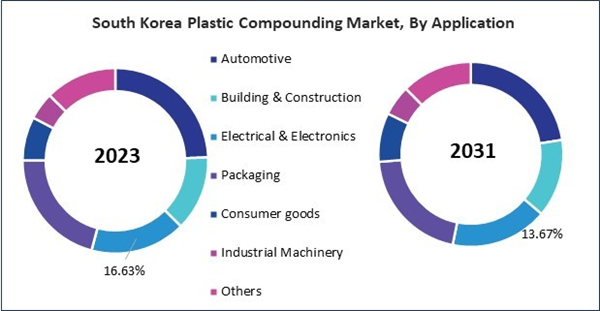PP compounds are extensively employed in interior and exterior components, such as bumpers, dashboards, and door panels, thanks to their lightweight nature, impact resistance, and ability to withstand harsh weather conditions. Thus, the South Korea market utilized 1,421.6 kilo tonnes of plastic compounds in the market 2022.
The China market dominated the Asia Pacific Plastic Compounding Market by Country in 2023, and would continue to be a dominant market till 2031; thereby, achieving a market value of $13,316.5 million by 2031. The Japan market is showcasing a CAGR of 6.5% during (2024 - 2031). Additionally, The India market would register a CAGR of 7.9% during (2024 - 2031).
The market is a dynamic and rapidly evolving sector that shapes various industries. Plastic compounding involves blending polymers with additives, fillers, reinforcements, or other materials to create customized compounds with specific properties and performance characteristics.
Moreover, these compounded plastics have widespread applications across diverse industries, from automotive and construction to packaging, electronics, and consumer goods.
China's rapid urbanization and infrastructure development efforts have created immense demand for construction materials, including plastic compounds. With millions of people migrating from rural to urban areas, there is a need for new residential buildings, commercial complexes, industrial facilities, and transportation infrastructure.
Based on Product, the market is segmented into Polypropylene (PP), Polyethylene (PE), Polyvinyl Chloride (PVC), Polystyrene (PS), Polyethylene Terephthalate (PET), Polycarbonate (PC), Polyurethane (PU), Polymethyl Methacrylate (PMMA), Acrylonitrile Butadiene Styrene (ABS) and Others. Based on Source, the market is segmented into Fossil-based, Bio-based and Recycled. Based on Application, the market is segmented into Automotive, Building & Construction, Electrical & Electronics, Packaging, Consumer goods, Industrial Machinery, and Others. Based on countries, the market is segmented into China, Japan, India, South Korea, Australia, Malaysia, and Rest of Asia Pacific.
List of Key Companies Profiled
- BASF SE
- Saudi Basic Industries Corporation (SABIC)
- Kraton Corporation
- LyondellBasell Industries Holdings B.V.
- DuPont de Nemours, Inc.
- RTP Company, Inc.
- Lanxess AG
- Covestro AG
- Arkema S.A.
- Chevron Phillips Chemical Company LLC
Market Report Segmentation
By Product (Volume, Kilo Tonnes, USD billion, 2020-2031)- Polypropylene (PP)
- Polyethylene (PE)
- Polyvinyl Chloride (PVC)
- Polystyrene (PS)
- Polyethylene Terephthalate (PET)
- Polycarbonate (PC)
- Polyurethane (PU)
- Polymethyl Methacrylate (PMMA)
- Acrylonitrile Butadiene Styrene (ABS)
- Others
- Fossil-based
- Bio-based
- Recycled
- Automotive
- Building & Construction
- Electrical & Electronics
- Packaging
- Consumer goods
- Industrial Machinery
- Others
- China
- Japan
- India
- South Korea
- Australia
- Malaysia
- Rest of Asia Pacific
Table of Contents
Companies Mentioned
- BASF SE
- Saudi Basic Industries Corporation (SABIC)
- Kraton Corporation
- LyondellBasell Industries Holdings B.V.
- DuPont de Nemours, Inc.
- RTP Company, Inc.
- Lanxess AG
- Covestro AG
- Arkema S.A.
- Chevron Phillips Chemical Company LLC
Methodology

LOADING...









